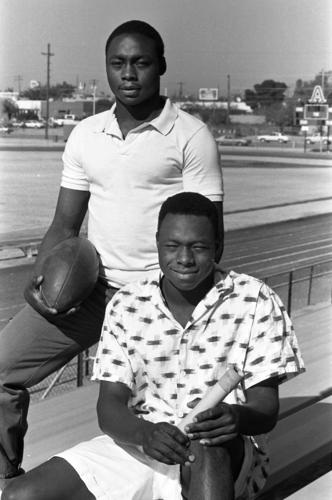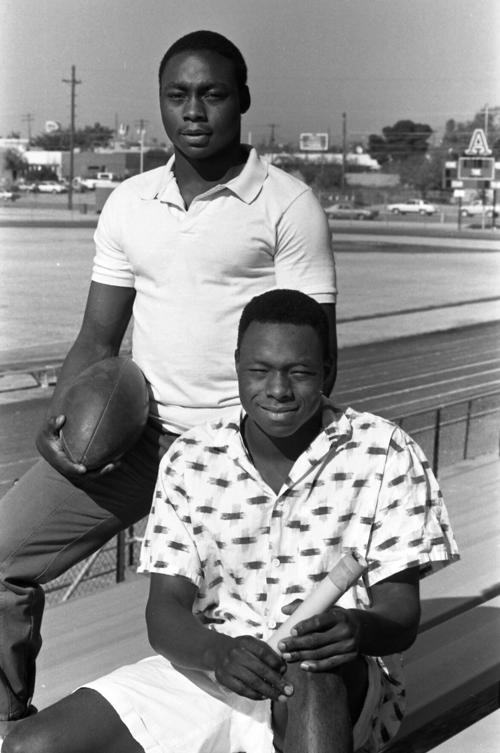If all had gone smoothly, Amphitheater High School might’ve won five consecutive state track and field championships at Arizona’s big-schools level, 1985-89.
After a decade of building the Panthers’ track program, coach Raul Nido broke through in 1985 and led Amphi to the state title.
“This program used to be nothing,” said Nido, who is one of the leading distance runners in Tucson history, winning a state championship cross country title at Sunnyside High School and then breaking the UA’s record in the steeplechase.
By ‘85, the Panthers track team had gone from nothing to something big.
Amphi was led by state championship sprinter Bernie Wharton, who won the 100 and 200; Nido referred to Wharton as “the franchise.” Nido was replaced by an even greater sprinter: Michael Bates.
Bates was a once-a-lifetime athlete, a Parade Magazine running back in 1988 and perhaps the leading football recruit in UA history. Bates won a bronze medal at 200 meters at the 1992 Barcelona Olympics and then became a five-time Pro Bowl football player in the NFL.

As an Amphi freshman in 1986, Bates state titles in the 100 meters, 200 meters and in the 110 hurdles. The Panthers finished second in the state finals, but it wasn’t an exaggeration to think that Amphi would win the next three state titles with Bates and his older brother, Marion, among others.
At the ‘87 state finals, Bates was even better. He again won the 100, 200 and 110 hurdles, all in state record times. Joined by his brother, Marion, who was second in the 200 and helped Amphi win the 4x100 relay, Amphi easily won the state championship.
It wasn’t all the Bates brothers, either. Teammate Kurt Browning was third in the long jump, Ed Mandelburg was fifth at 1,600 meters and discus thrower Kurt Nelson was sixth. In two years, Bates had won six state championships while becoming perhaps Arizona’s leading prep football player.
Better yet, he had two years remaining at Amphi.
“People say I’m going to burn out or something,” said Bates. “But I don’t think that will happen. I’m just going to keep getting faster and stronger.”
Which he did. But then outside forces knocked the Amphi program off track.
Nido announced he was resigning from coaching and would not return in 1988.
“I was just being pulled too many ways,” he told the Star. “There wasn’t time to go to school, coach and teach at the same time. Something had to give, so I decided to take a year away from teaching and coaching and go back to school to get a master’s degree.”
By 1990, Nido was the principal at his alma mater, Sunnyside, where he remained for almost 20 years.

Raul Nido, pictured in 2011, left his job as Amphi’s track and field coach to focus on getting a master’s degree. Nido went on to become Sunnyside High School’s principal.
Five months later, the Arizona Interscholastic Association placed an asterisk by Amphi’s 1987 state track championship, ruling that one of the Panthers’ distance runners was not eligible. Amphi disputed the ruling. But the asterisk remains.
Under new coach Ron Englehard, Amphi was again the favorite to win the state title, in 1988. But the day before the AAA-South region track meet was held on Amphi’s track, Bates and eight other Panthers showed up for an unsupervised workout.
A rival sprinter athlete reported that he saw a handful of Panthers jogging and exercising at the track. A day later, the Arizona Interscholastic Association ruled those nine Amphi athletes ineligible for the rest of the year. It was like issuing a ticket for driving 56 mph in a 55 mph zone.
When Catalina sprinter Pat Thomas won the 100 and 200 meter events at the region meet a day later, he said: “The medals are like plastic to me.” He had hoped to run against Bates.
No one in Arizona prep sports would run against Bates again. He was forced to miss the state finals for the minor offense of jogging around the Amphi track a day before the region meet.
“We thought the rules pertained to organized practices,” he said. “We were just working out.”
A year later, Bates chose not to compete in the high school track season, partly out of a distaste for the AIA’s ruling and partly to concentrate on completing academic requirements so that he could enroll at Arizona in the fall of 1989.
At Arizona, Bates became a school-record holder in the 100 and 200 meters, winning Pac-10 championships in both events in 1990 and 1991 before leaving school to concentrate on the 1992 Olympics and then prepare for the NFL draft.
Amphi’s track legacy of the 1980s remains intact. The Panthers were the last Tucson school to win the state boys track championship at Arizona’s highest classification.








